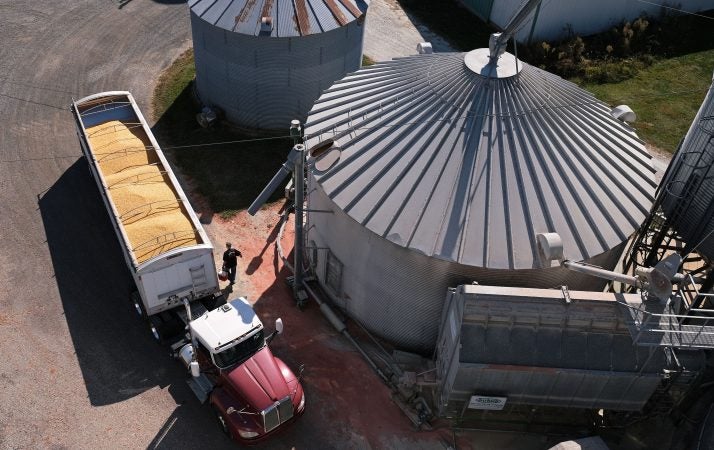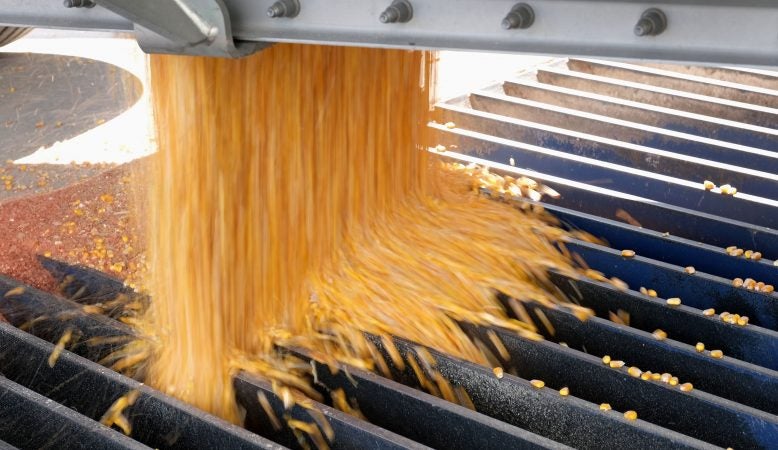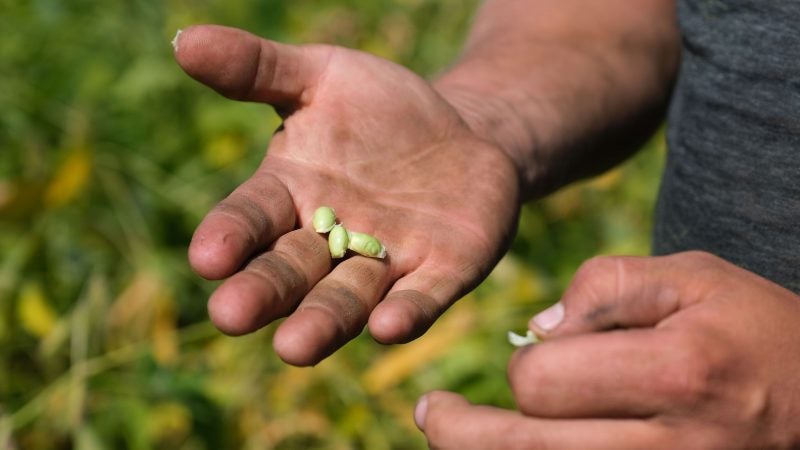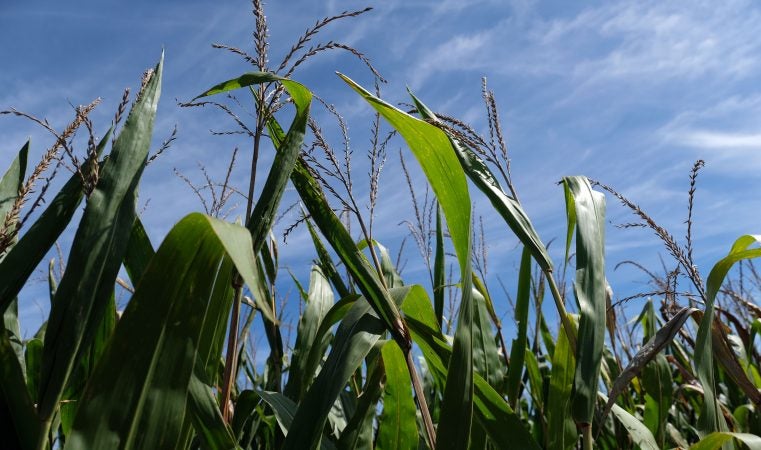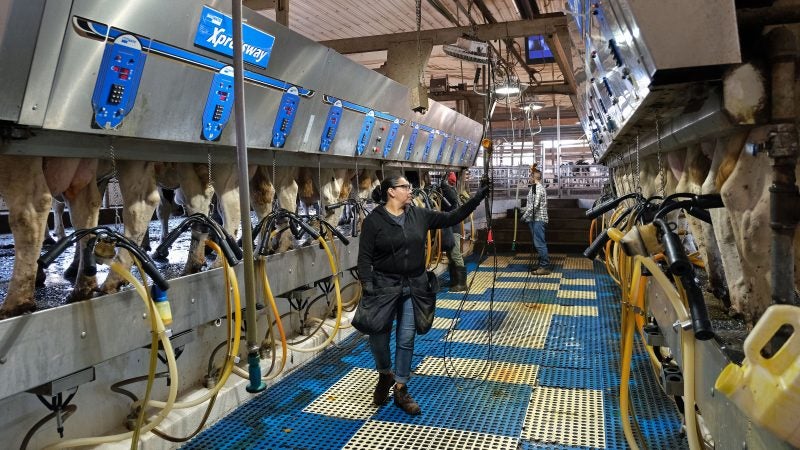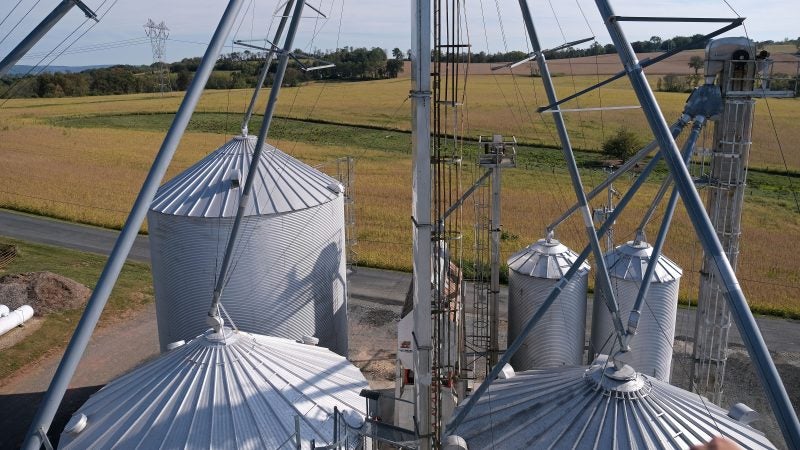Amid Trump’s trade war, Pa. farmers fight to survive in an uncertain market
In the midst of the second harvest under the trade war, Pa. farmers discuss how the policy affects them and what it takes to survive in an unstable and uncertain market.
Don Cairns is driving through rural Chester County between one of his many plots of farmland. He grows corn, wheat, and soybeans on about 1,700 acres. It’s a hot, dry day — perfect for harvesting. He’s busy shuttling fresh-cut corn from the field back to his silos for storage.
In a sun-faded camouflage cap, a dusty brown t-shirt and blue jeans, Cairns lugs a large semi-truck hauling a grain trailer onto the cornfield. There, a combine outfitted with the latest technology analyzes the yields as it ploughs the field and shells the kernels from the cobs.
Cairns radios his farmhand to ask him for the current count. A few moments later, the report comes back: 233 bushels to the acre.
“For a farm average, that’s really good,” said Cairns. “I’m really happy with that.”
Right now, every kernel matters. If Cairns makes a little extra money on his corn, it could help cover some of his losses on soybeans. He’s been losing money there since the trade war began, when China slapped tariffs on American soybeans in July 2018.
Soybean sales to China completely dried up, and prices dropped. Cairns said he lost $40,000 last year.
“We’re selling soybeans for way less than the cost of production,” he said.
As the United States’ trade war with China continues, agriculture remains one of the hardest hit sectors of the economy and soybean farmers have borne the brunt of it. China is the largest importer of soybeans in the world and took almost 50% of American exports before the trade war began.
In the midst of the second harvest under the trade war, Keystone Crossroads spoke to several Pennsylvania farmers about how the policy affects them and what it takes to survive in an unstable and uncertain market.

‘All the basics’
Cairns initially thought the dispute with China would only last a few months. Now, more than a year and a half later, soybean prices are just as bad.
He doesn’t like taking losses, but for him and other grain farmers in Pennsylvania, the trade war has not caused a crisis. Unlike many farms in the Midwest that focus solely on soybeans, farms here are diversified. Pennsylvania farmers typically grow more than one type of crop, raise livestock on the side, or hold other jobs outside of farming.
“If I was only growing soybeans, we’d be really, really hurting,” said Cairns.
Cairns is one of the largest grain growers in Chester County. He said that in order to make grain farming your sole livelihood, it takes a lot of land, which helps lower the cost per acre. But even on a large scale, his farm operates on thin margins. He has mortgages on the 230 acres he owns and he leases the rest of his acreage from neighboring families.
Cairns also invested $500,000 into his grain drying and storage facility about ten years ago. The investment pays. It allows him to avoid paying a local grain elevator to dry his grain and it gives him the flexibility to store some of his crop until the market improves. But he still owes about $125,000 on that loan.
It’s not unusual for farmers to take out loans for new equipment or additional acreage, or even extend a line of credit on production costs for a year’s crop. But Cairns says he makes a point to keep his debt low, even if that means investing all of his revenue into the ground.
“By the time we get to harvest next year and I’ll have everything invested in that crop, I’ll have over a million invested. That should make you lose sleep at night,” he said. “But I’ve learned to trust it. Not that we’re not gonna have problems. But we have to trust that God’s gonna take care of us.”
Cairns grew up in Chester county. His dad worked for the electric company, and his family did some hobby farming on the side. He said he always knew it was his calling to have a farm of his own. He worked as a commercial insurance broker for 13 years in Philadelphia before he and his wife took the plunge. They bought some land in his old neighborhood and moved into farming full time. That was 22 years ago.
Cairns raised two kids on the farm with his wife, and said their family lives comfortably, but frugally.
“We don’t go on fancy vacations. We drive old cars, just all the basics,” he said. “We’ve tried never to borrow money to buy regular stuff. You need a new refrigerator, you wait till you can afford to pay for it. You need a new car, you buy a used one and pay cash.”
Cairns said he was contending with low prices even before the trade war began. There were three years where he broke even on soybeans before prices dropped even further last July. Prices across all commodities, from grain to dairy and livestock, have been depressed for several years now.
Dwight Rohrer, a senior agricultural lender at First Citizens Community Bank, said that agriculture is in a recession, and not all farms can weather the low prices. In order to stay afloat, he says farms need to practice good management and keep their production costs as low as possible.
“The prices that farmers are receiving for their products are probably down 30 to 50% from where they had been. That has just forced the industry to weed out some folks that were not able to survive,” Rohrer said.
From Rohrer’s position as a lender, he has seen the trade war accelerating a trend that was already occurring in Pennsylvania. Smaller producers are being forced to either expand, quit, or transition to a niche market, like raising organic chicken or antibiotic-free pork.
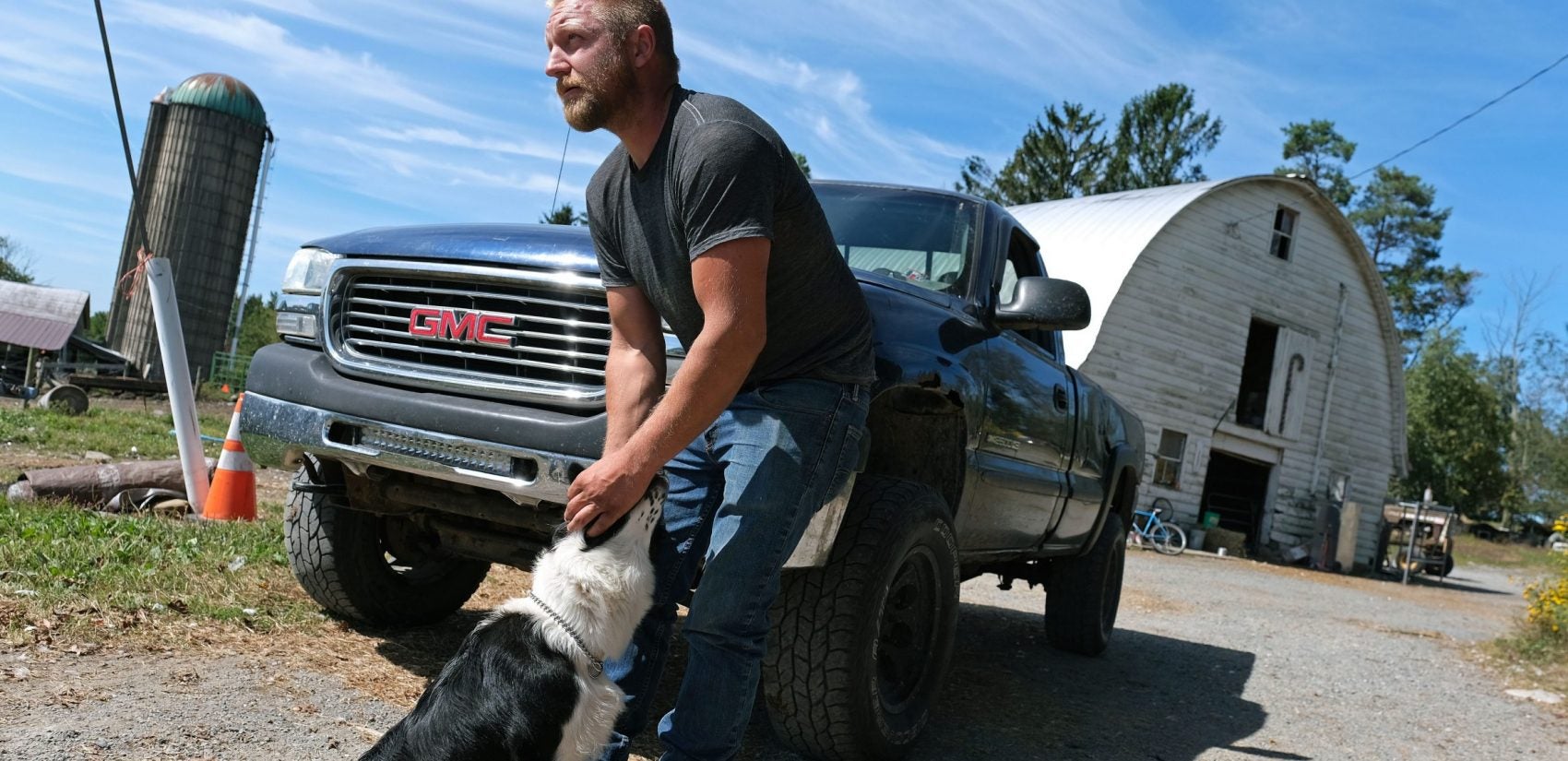
‘Can’t blame all this on Donald Trump’
Changes to farming in Pennsylvania mirror the national trend. The total number of farms in the United States has declined as smaller farms have closed. Between 2012 and 2017, when the last Census of Agriculture was conducted, the number of farms in the U.S. decreased by 3%. In Pennsylvania, the number dropped by 10%.
Jesse Poliskiewicz, a grain farmer in Northampton County who grew up on a dairy farm, has seen this trend firsthand.
“Where you had a family taking care of a hundred acres, now that same family has to farm five or 600 acres to make it go,” he said. “It’s hard. You can’t make a living on just 80 to 100 acres of land. I mean, you can make some money, but not enough to cover all your expenses.”
Poliskiewicz said that one of the drivers behind the recession in commodity prices is global oversupply. Advancements in technology have increased yields, and demand has not kept up.
“You can’t blame all this on Donald Trump and the trade war,” he said.
After graduating from Bangor Area High School in 2002, Poliskiewicz started farming about 80 acres on his family’s land. He tried college for a few years, but realized that farming was in his heart and soon committed full time. When he started making money selling feed and hay, he thought about expansion.
“I was like, ‘Hey, if I had a little bit more land, I could make some more money,’” said Poliskiewicz. “And there’s other guys who influenced me in the area, other local farmers who were doing quite a bit of acreage and I’d see what they had and I’d be like, ‘Wow, that’s neat.’”
At 35, he’s about 20 years younger than the average farmer in Pennsylvania, and he has no shortage of ambition.
Today, he farms 1,200 acres of corn, soybeans, and wheat. In addition to farming, he runs a local general store with his partner, Aline Haddad. The pair were neighbors growing up, but didn’t know each other.
Then came a twist of fate. In 2015, Haddad’s truck broke down and she came knocking on his door to ask for help. A couple days later when she returned to thank him, he asked her out.
Poliskiewicz said the support of their two families have been crucial to running the store.
“If it wasn’t for them, we probably wouldn’t be opened right now,” he said. “They just want to see the next generation try to keep this area alive and rural and keep going.”
In the face of volatility in the market, he’s also experimenting with crop selection. Next year, he plans to grow sunflowers to harvest for bird seed, and try his hand at quinoa.
“I want to try to throw something else into the mix, a variety to try to make a little bit better money, [rather] than have to rely on the corn and soybean market that is basically controlled by our government,” Poliskiewicz said.
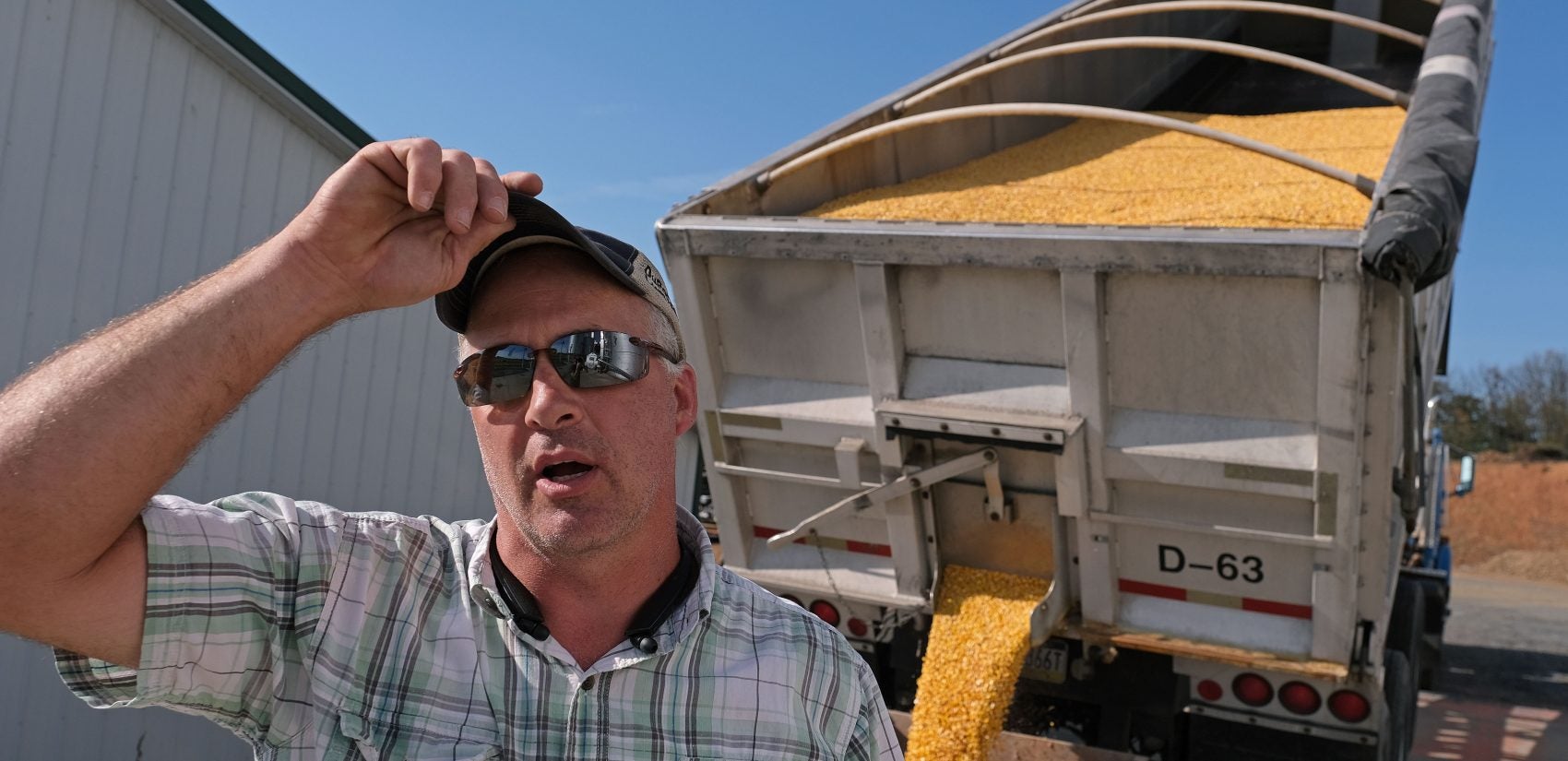
‘Farmers don’t sleep very well’
Michael Braucher, 51, grows corn, soy, hay and raises some livestock on his Berks County farm. Still, he says his farm is not as diverse as it should be, and is quick to bring up the anxiety of farming.
“It’s very emotionally, mentally and physically stressful,” he said. “Most farmers don’t sleep very well. There’s just too much happening that affects what we do.”
Braucher said he has also lost revenue due to the trade war. But to him, it’s just one more thing that farmers have to manage in a laundry list of challenges such as the weather, pests, disease and changes in supply and demand. He constantly tries to see where his operation fits into world dynamics.
When he wakes up in the middle of the night, he checks the international news to see how it might affect his business. For example, when oil prices rose after facilities in Saudi Arabia were attacked in late September, he immediately began an internal personal calculus.
“That can be thousands of dollars within a few minutes. Not just for fuel and gas, but also for a lot of the fertilizer costs. It spreads throughout everything,” he said.
Don Cairns said that even if the dispute with China is resolved, he will still need to deal with what he sees as a perfect storm of market pressures conspiring to keep prices down. Global oversupply is one, but there’s also the threat of African swine fever in China. Pork production is one of the major markets for soybeans in China, and the outbreak reduced the country’s hog herd by half in just eight months.
The agricultural economy is interconnected, and one farmer’s pain can work to another’s advantage. Duane Hershey, a dairy farmer in Chester County, said he likes that he can buy the grain that he needs to feed his cows at a discount price right now. But the dairy industry has also been hit by tariffs from China, so it’s complicated.

“I would rather be paid a more fair price for the milk,” said Hershey. “I guess what I’m saying is, I don’t like when it hurts one sector of agriculture and helps another. But I have been able to lock in some lower feed prices because of it.”
Hershey took over the farm from his parents, who never milked more than 50 cows at a time. Now, almost 20 years later, he milks 700. He learned early that he needed to expand to stay viable.
“When I added cows, that was basically spreading out my fixed costs into more cows to produce more milk, to become more efficient, to figure out how to survive when the prices drop. That’s the name of the game — reduce expenses to try to improve cash flow,” Hershey said. “If I was still at 50 cows, I probably wouldn’t have cows right now.”
‘Buying votes’
The longterm consequence of the trade war is yet to be known. The U.S. spent years cultivating relationships with buyers in China and building up the soy market. But now, China has turned to South America for their beans. What if that market doesn’t come back?
John Berry, a recently retired marketing and business educator from Penn State Extension, said trade wars during the Jimmy Carter and Richard Nixon presidencies resulted in lost U.S. market share.
“That, I think, is where we’re going,” said Berry. “We can argue about it in the meantime, or we can throw money at it like we’re doing now to have aid packages to try to save the farmer…some people call that buying votes.”
President Trump has publicly thanked farmers for being the martyrs of his trade war. In return, the administration has tried to reduce the burden on farmers with a bailout package called the Market Facilitation Program. Last year, the USDA paid more than $8 billion to producers who applied. Pennsylvania farmers got $45 million.
Trump plans to double the subsidies this year, offering up to $16 billion. That would bring the program total to twice as much as the auto industry bailout cost taxpayers during the Great Recession.
All of the farmers in this story were recipients of the program, but each stressed that they would rather not have to rely on subsidies.
“We’re not looking for a handout. We wish we didn’t need subsidies. We just want to make a fair return on the products that we’re growing,” Cairns said.

He said the payments did not cover all of his losses, but last year would have been much worse if he hadn’t signed up.
Cairns voted for Trump in the last election. He doesn’t agree with all of his policies, and he’s not happy about how the trade war is affecting him personally. But, he said he understands the need for the country to be tougher on China with issues, for instance intellectual property infringement, that hurt other U.S. businesses.
“I’m not turning away from our president because of the trade war. I just hope we can get it resolved,” Cairns said.
Poliskiewicz also voted for Trump in the 2016 election, but said that he does not support him or the trade war anymore. He thinks the presidency is like a game to Trump. He felt that Trump was really talking to farmers when campaigning, but the president has not lived up to his expectations.
“He had a big plan for farmers and this trade war was never even thought about. A lot of farmers voted for President Trump,” he said. “I think it’s just like any other elected official. They say what the people want to hear to get into office. You think you’re making the right choice by voting and…it’s a gamble.”
American trade talks with China are scheduled to resume on Thursday.
—
Matt Smith contributed reporting.
WHYY is your source for fact-based, in-depth journalism and information. As a nonprofit organization, we rely on financial support from readers like you. Please give today.






